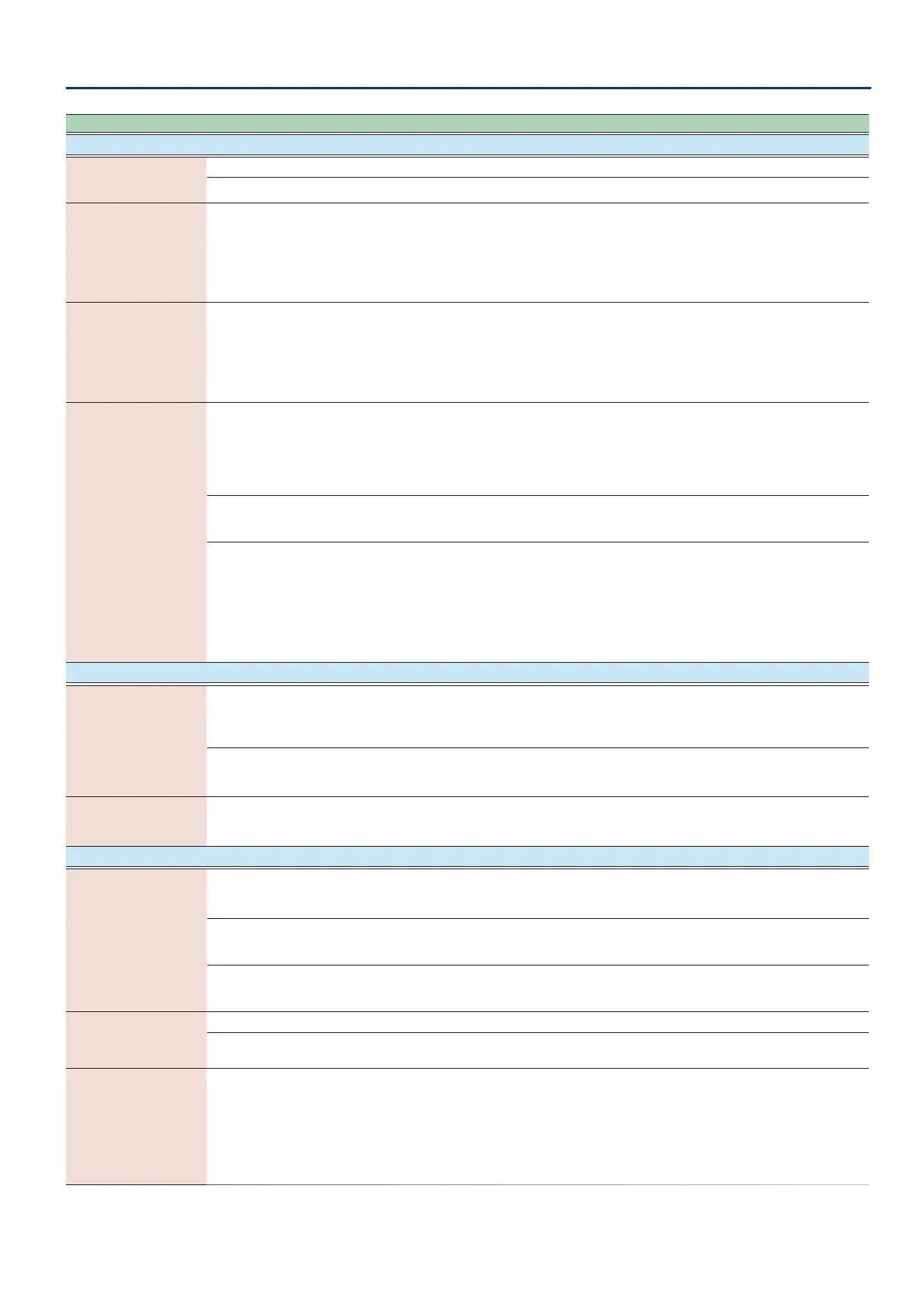Troubleshooting
183183
Problem Items to check Action Page
Problems with the sequencer
After recording, there’s
no sound when you
play back the pattern
Could a specic track be muted? Defeat muting.
p. 113
Could a specic track be soloed? Defeat solo.
p. 114
The tempo is dierent
than when the pattern
was played a previous
time
Did you save the scene?
When you change the tempo and play back, the FANTOM
does not save that tempo unless you save the scene. If you
want to keep the modied tempo, save the scene.
p. 56
After playing a song on
the sequencer, there is
no longer sound
Could the song data contain data that set the
volume to zero?
After playing a song that ends with a fade-out, sound might
no longer be heard. In this case it may be that a volume
message or expression message has lowered the volume.
Check each value and set it appropriately.
–
Performances are
sluggish, or have
interruptions
The sound will be interrupted if the maximum
polyphony is exceeded.
Try reducing the number of notes that are played.
In some cases, sustained notes with a long release might
cause processing to continue even though the notes are no
longer actually audible. In such cases, the polyphony of the
performance data diers from the number of notes that you
hear.
–
Is there an Aftertouch or other such large
Control Change at the point where the song
performance is sluggish?
If the data is no longer needed, delete the data.
p. 129
Is the data concentrated at the beginning of the
beats in the sequence data?
Try spreading the data apart so that it does not occur at the
same timing (microscope).
It is easy for data to be concentrated at the rst beat of
the song if you use step recording to enter the song data,
or if you apply quantization after realtime input from the
keyboard. This causes a large amount of data to be sent to
the FANTOM in a short time, possibly causing a delay in note
processing.
p. 126
Problems with saving
A scene sounds
dierent than when
you saved it
Save the tones.
If you edit the tones used by scene, or if the temporary
tones of the scene were rewritten from an external MIDI
device, you’ll need to save those tones as well.
p. 64
Check the eect settings.
It might be that the master eect (system eect) settings
have changed.
p. 69
Arpeggio and controller
settings dier between
studio sets
Check the arpeggio and controller settings.
Arpeggio and controller settings are independently saved
for each scene.
p. 42
Problems with external MIDI devices
No sound from an
external MIDI device
Does the MIDI transmit channel of the zone set
to EXT match the MIDI receive channel of the
connected device?
Match the zone’s transmit channel with the connected
device’s receive channel.
For details, refer to “Parameter Guide” (PDF).
–
Is the zone that you want to output MIDI unlit, or
set to EXT?
Unless the current zone is unlit, or unless one of the zones
is set to EXT, playing the keyboard will not transmit MIDI
messages.
p. 8
Is the zone set to EXT assigned to output MIDI?
Unless the zone set to EXT is the current zone, or unless
the keyboard is connected via a layer that includes another
current zone, MIDI messages are not transmitted.
p. 8
Exclusive messages are
not received
Could Receive Exclusive be turned “OFF”? Turn Receive Exclusive “ON”.
p. 168
Does the transmitting unit’s Device ID number
match the FANTOM’s Device ID number?
Set the Device ID numbers.
p. 167
When the tone’s bend
range is large (48), the
pitch does not rise to its
full extent when a MIDI
pitch bend message is
received
Although a tone’s bend range can be set in a
range of 0–48, there are some waves for which
the pitch cannot rise to the full extent of the
pitch bend message, causing the pitch to stop
rising at a certain point. We guarantee that the
pitch will rise at least to a pitch bend range
setting of 12, but please use caution if you
specify a bend range that is greater than this.
–
–

